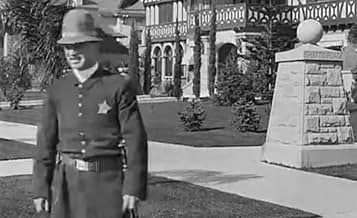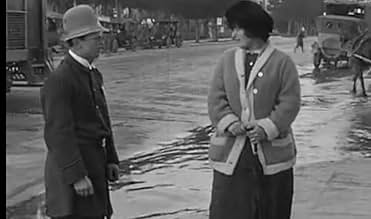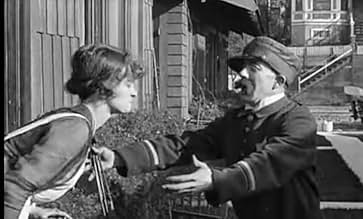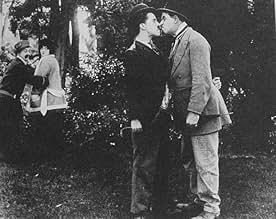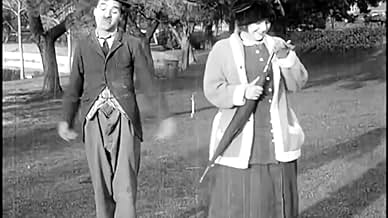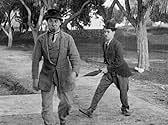Ajouter une intrigue dans votre langueCharlie and another man compete in trying to help a young lady cross a muddy street. The rival finds a wooden plank which Charlie takes from him. They fight over an umbrella belonging to the... Tout lireCharlie and another man compete in trying to help a young lady cross a muddy street. The rival finds a wooden plank which Charlie takes from him. They fight over an umbrella belonging to the rival. A policeman settles the dispute, ultimately arresting the rival. An innocent tramp... Tout lireCharlie and another man compete in trying to help a young lady cross a muddy street. The rival finds a wooden plank which Charlie takes from him. They fight over an umbrella belonging to the rival. A policeman settles the dispute, ultimately arresting the rival. An innocent tramp is pushed into the lake.
- Réalisation
- Scénario
- Casting principal
Avis à la une
** 1/2 (out of 4)
After a rainy day a woman (Emma Bell Clifton) is trying to get across a muddy street when a man (Ford Sterling) offers to help but soon a Tramp (Charles Chaplin) tries to help as well. Soon the two men are fighting and others jump in. This was Chaplin's fourth film as an actor, the third playing the Tramp and in my opinion the first one where he could call himself the star. It's rather amazing to see how far advanced Chaplin was even though he hadn't yet turned the character into the masterpiece we all know him for. Just look at how Chaplin acts compared to everyone else in the film. I'm certainly not saying the others are bad but they are typical of what you'd see in a Keystone film and then there's Chaplin doing his magic. The first five minutes are the best when Chaplin is losing his balance as he tries to flirt with the woman and eventually has one of his feet fall in. The joke that happens when he pulls his foot out is priceless. The rest of the film is rather routine and I doubt too many will find laughter but if you want to see Chaplin evolve then this here is important.
Of historical interest.
The editing is poor enough to lose the plot from time to time, if there is a plot that extends beyond the individual slapstick-filled scenes.
The film has a certain slight charm as an historical curiosity. Here it is -- 1914 in Los Angeles, and what looks like Echo Park might have looked in 1914 Los Angeles.
A dog wanders innocently in and out of a scene but nobody cares. The pratfalls are backward somersaults. It's all very casual and lacks poetry.
He did do better than 'Between Showers'. Can understand why the Keystone period suffered from not being as best remembered or highly remembered than his later efforts, but they are mainly decent and important in their own right. 'Between Showers' is a long way from a career high, but does have historical significance for obvious reasons.
'Between Showers' is not as hilarious, charming or touching as his later work and a good deal of other shorts in the same period. The story is flimsy and the production values not as audacious, the humour only amusing and lacking freshness at times.
For someone who was new to the film industry and had literally just moved on from their stage background, 'Between Showers' is not bad at all.
While not audacious, the film hardly looks ugly, is more than competently directed and is appealingly played. Chaplin looks comfortable for so early on and shows his stage expertise while opening it up that it doesn't become stagy or repetitive shtick. The Tramp did become more likeable later but again he was still evolving.
Although the humour, charm and emotion was done even better and became more refined later, 'Between Showers' is mildly humorous, sweet and easy to like, though the emotion is not quite there. It moves quickly and doesn't feel too long or short.
Overall, far from one of Chaplin's best but not bad at all. 6/10 Bethany Cox
In this one, Chaplin shares the screen with another big star of the time, Ford Sterling. These two fight over the attention of the woman (and over the umbrella). Although, Ford Sterling's character seems to fight more with the woman, than with the other man. I guess I didn't find the blatant beating of the woman that funny (oh, the modern 'soft' man).
The film had some moments that proved to grow into something, but I guess the rushed production prevented the development of more elaborate gags. The film itself is not very memorable but it gives us a good comparison between young Charles Chaplin and an already established star. When you pay attention to the styles of these two comedians then it is clear why the world still remembers and hails on as the greatest of all times while the other is totally forgotten (besides by the small subculture of silent comedy aficionados). Chaplin's star started to shine almost immediately.
Le saviez-vous
- AnecdotesEmma Bell Clifton was hired by Mack Sennet because she resembled Mabel Normand. Some reviews mistakenly list Normand in the credits of this film and another film featuring Chaplin and Clifton called "A Film Johnnie".
- ConnexionsFeatured in Charlie Chaplin, l'homme le plus drôle du monde (1967)
Meilleurs choix
Détails
- Date de sortie
- Pays d’origine
- Sites officiels
- Langues
- Aussi connu sous le nom de
- Between Showers
- Lieux de tournage
- MacArthur Park, Los Angeles, Californie, États-Unis(Westlake Park)
- Société de production
- Voir plus de crédits d'entreprise sur IMDbPro
- Durée15 minutes
- Couleur
- Mixage
- Rapport de forme
- 1.33 : 1
Contribuer à cette page


